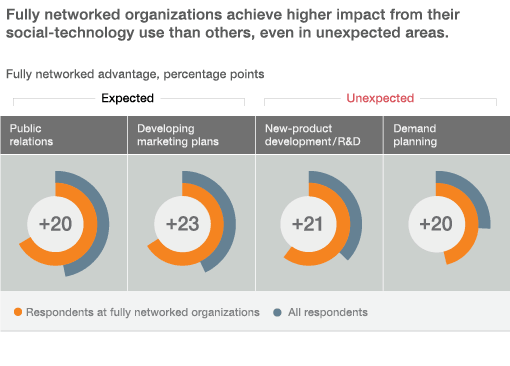
After years of rapid and increasing adoption, the use of social technologies has become a common business practice. Now the responses to McKinsey’s latest survey on these technologies indicate that in certain functions (namely, sales and marketing), companies are applying social tools extensively and becoming more digital organizations overall.1 We asked executives about their companies’ use of social tools in 18 specific business processes. Among them, social technologies are the least integrated into the work flow for operations processes, such as order to cash and demand planning. They are the most integrated into public-relations, customer-relationship-management (CRM), and marketing processes—where these technologies are a natural extension of existing tools. As a result, executives say the use and integration of social tools have had the most significant impact on the day-to-day work for many customer-facing activities.
To achieve this impact and increased productivity across the entire business, most companies must become better at engaging more employees, customers, and external partners through social tools, then capturing new benefits and measuring them in a systematic way. At the companies seeing the greatest benefits from social interactions, respondents are much likelier than others to say these tools are highly integrated into all processes, not only their sales-and-marketing activities. The journey is difficult: even companies reaping the greatest benefits still struggle to measure the impact and potential value these tools can bring to their business. But the steady climb in the use of social across platforms—along with the growing shares of respondents reporting outsize benefits from social interactions—indicates that significant gains can still be made. What’s more, executives are much more optimistic than in past years that their companies’ investments in social tools will grow. This result suggests that many more organizations will be able to realize additional value from technology use in the coming years.
Seeing social’s impact on processes and work flow
While we have asked more generally in previous surveys about the business uses of social technologies (which groups of employees use social technologies in their work, for example, and whether social interactions are internal, external, or both), the latest survey asked about technology adoption in 18 specific processes, across functions, for the first time. According to respondents, social tools are used much more often in some processes and activities than others: namely, in customer-engagement processes such as public relations, customer relationship management, and the execution of marketing activities (Exhibit 1). The use of social is much less common in operations processes, such as order to cash and procurement, where there is particularly high potential for companies to increase the value they are reaping from these technologies.
Social tools are used most for customer engagement and least in operations processes.

Where social tools are used, respondents say processes have changed notably as a result—particularly for developing customer insights and competitive intelligence, where 62 percent of respondents say the use of social technologies has significantly changed the work flow. Executives also report that in the processes where social tools are used most often, tools tend to be integrated more deeply into day-to-day tasks—suggesting that companies must adjust the way they work to get the full value from these technologies. Among the processes we asked about, the largest shares of respondents say technologies are very or extremely integrated into the work flow for customer-facing activities: public-relations processes, the development of marketing plans, and the execution of marketing activities. The smallest shares report a high level of integration for order-to-cash and demand-planning processes.
At fully networked organizations—the companies seeing the greatest benefits from internal and external use of social technologies2 —executives report greater-than-average use of these tools in each process. They also say the technologies are more embedded in their work (Exhibit 2). These executives, like all others, report the greatest impact from using social tools in public-relations processes. But relative to the global average, they also report an outsize impact from using social in demand planning, CRM, and after-sales services (Exhibit 3). For companies struggling to prioritize the highest-impact areas and processes where they could use social, these results suggest some good starting points where other organizations have achieved success, as well as some undervalued areas where there is considerable potential for companies to get ahead of competitors if they use social tools.
At fully networked organizations, social technologies are integrated more deeply into day-to-day work.

Fully networked organizations see more impact from their social-technology use.

Overall use of social tools plateaus, and their benefits are hard to measure
More broadly, this year’s results confirm that company adoption of social technologies is maturing. Executives continue to say their companies use highly interactive technologies, such as online videoconferencing and social networking, more often than less engaging tools, such as wikis and podcasts.3 The use of social tools with customers or among employees is still more common than using tools with external business partners, although executives report only incremental changes in the internal or customer-related benefits their companies gain.
On the other hand, the companies that do interact with business partners, suppliers, and experts through social technologies are seeing growing benefits. Just 41 percent of respondents say their companies interact with these groups at all through social technologies. But of those that do, 66 percent say their companies have benefited from increased speed to access knowledge, up from 53 percent last year (Exhibit 4).
Respondents cite a growing number of benefits from social interactions with external business partners.

The share of fully networked organizations seeing outsize benefits from social interactions is also growing, albeit at a measured pace. Twenty-four percent of organizations now qualify as fully networked, up from 20 percent in the past two surveys. Their responses suggest that for all other companies (those that are developing or are only internally or externally networked4 ), there’s much more potential value to capture from social technologies—especially since most organizations already have a foundation in place for technology use. Eighty-two percent of respondents (the same percentage as last year) say their companies have adopted at least one social tool in their business.
For many companies, the use of metrics could facilitate higher returns from social tools. In practice, few of them—even those that are fully networked—are effectively measuring the benefits from social. Just 32 percent of all respondents say their companies use quantitative measures to assess the impact of their social-technology use. Fully networked organizations do better (52 percent at these companies report using quantitative measures), but there’s still room for many of them to improve.
What’s more, majorities of respondents say there are no metrics in place to measure the benefits their companies see from internal use, use with customers, or use with partners and suppliers, which was also true in last year’s survey.5 Social tools could provide companies with data on processes and practices they’ve never measured before (the level of communication among individual employees, for example). But many organizations must still learn how to use such measures. Our experience suggests they can also use existing, targeted metrics for areas such as customer satisfaction, up-sell conversion, and employee engagement to measure the success of social tools by comparing changes in these metrics against control-group areas where no social tools have been used.
Optimism ahead for social
While the overall usage of and benefits from social tools have been roughly consistent over the past two years, executives believe the future of social looks brighter than even before. Seventy-two percent expect that in the next three years, their organizations’ investments in social tools will increase—up from 58 percent who said so last year (Exhibit 5). This change suggests that the depth of adoption within enterprises might increase even further in the future.
A growing share of executives expect their companies’ investments in social will increase.

The use of technologies on mobile devices is another bright spot, as it continues its steady rise: 72 percent of executives now say their companies’ employees use at least one social tool on mobile, up from 67 percent last year and 65 percent in 2012. Overall, the use of social tools on smartphones is more common than use on tablets. And for certain employees, mobile use is especially (and increasingly) prevalent. While more executives than ever report that employees across all functions are using social tools on mobile, respondents still cite employees in marketing, sales, and IT most often as mobile users (Exhibit 6). These employees are more likely to use social tools on mobile than on nonmobile devices; they also work on the business processes where social tools are most integrated into daily work.
Employees in marketing, sales, and IT are the likeliest to use social tools on mobile devices.

In the coming years, nearly all executives believe that social technologies could effect some key changes in structural and management processes. Their visions of social’s potential diverge, though, depending on the benefits their companies currently see. At internally networked organizations, executives believe the use of social could democratize decision making. Fifty-one percent cite data-driven decisions as a likely change at organizations without constraints (compared with 33 percent of the total average), and 24 percent cite the use of internal markets and voting mechanisms to allocate resources (compared with 16 percent). At fully networked organizations, executives most often predict the organization’s formal hierarchy would become flatter or disappear altogether.
Looking ahead
- Begin with a targeted approach, then broaden impact. While the overall adoption of social tools remains widespread, the results indicate that most companies use them intensely in only a few functional processes. Yet the successful use of social in sales-and-marketing processes suggests how much more potential value is at stake in other parts of the business. To get the most value out of social technologies, companies should focus on specific cases where these tools could be implemented in a targeted way. A company already using social tools could broaden the technologies’ impact by adopting them in areas such as operations, where they are used less often now.
- Focus on metrics. As companies adopt (and adapt) these relatively new technologies in their business, they also face the challenge of measuring data they’ve never seen or worked with before. To use social tools more effectively and understand where and how they can add future value, companies must mind how to measure the impact from tools already in use. One approach is comparing existing metrics from areas of the business where social is used against control-group areas without social tools. But the best methodology depends on the process and what benefits companies ultimately want to see.
- Change the way people work. Executives are optimistic about the potential business value from social tools—a common attitude toward new technologies. There’s an initial growth phase that drives adoption and excitement around the technology, but then companies need time to figure out how to use it to drive real productivity improvements. To reach the next S-curve of value from social tools, companies must think more holistically about the organizational and cultural changes to make.6 Social tools have the potential to change organizations, but only if those tools are implemented in a way that changes how individual employees work day to day.


